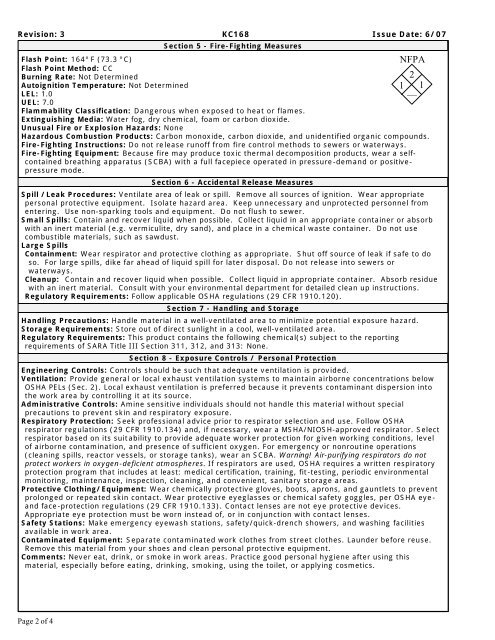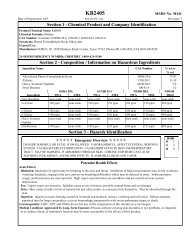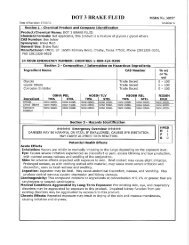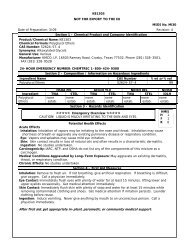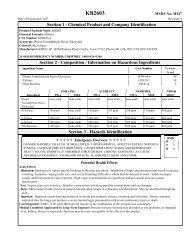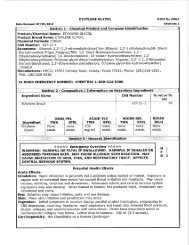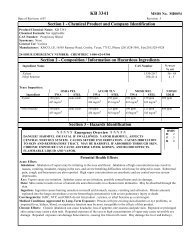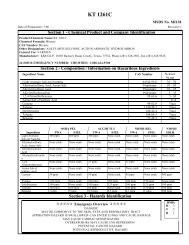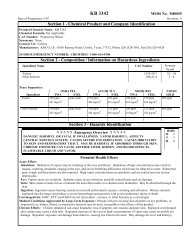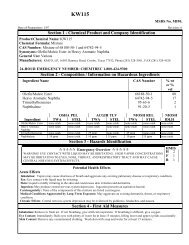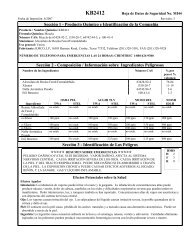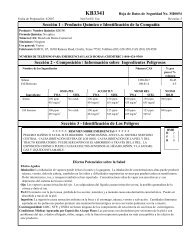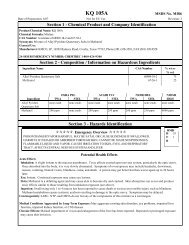KC168 MSDS No. MI63 Date of Preparation: 6/07 Revision: 3 - KMCO
KC168 MSDS No. MI63 Date of Preparation: 6/07 Revision: 3 - KMCO
KC168 MSDS No. MI63 Date of Preparation: 6/07 Revision: 3 - KMCO
You also want an ePaper? Increase the reach of your titles
YUMPU automatically turns print PDFs into web optimized ePapers that Google loves.
<strong>Revision</strong>: 3 <strong>KC168</strong> Issue <strong>Date</strong>: 6/<strong>07</strong><br />
Section 5 - Fire-Fighting Measures<br />
Flash Point: 164° F (73.3 ° C)<br />
Flash Point Method: CC<br />
Burning Rate: <strong>No</strong>t Determined<br />
2<br />
Autoignition Temperature: <strong>No</strong>t Determined<br />
1 1<br />
LEL: 1.0<br />
—<br />
UEL: 7.0<br />
Flammability Classification: Dangerous when exposed to heat or flames.<br />
Extinguishing Media: Water fog, dry chemical, foam or carbon dioxide.<br />
Unusual Fire or Explosion Hazards: <strong>No</strong>ne<br />
Hazardous Combustion Products: Carbon monoxide, carbon dioxide, and unidentified organic compounds.<br />
Fire-Fighting Instructions: Do not release run<strong>of</strong>f from fire control methods to sewers or waterways.<br />
Fire-Fighting Equipment: Because fire may produce toxic thermal decomposition products, wear a selfcontained<br />
breathing apparatus (SCBA) with a full facepiece operated in pressure-demand or positivepressure<br />
mode.<br />
Section 6 - Accidental Release Measures<br />
Spill /Leak Procedures: Ventilate area <strong>of</strong> leak or spill. Remove all sources <strong>of</strong> ignition. Wear appropriate<br />
personal protective equipment. Isolate hazard area. Keep unnecessary and unprotected personnel from<br />
entering. Use non-sparking tools and equipment. Do not flush to sewer.<br />
Small Spills: Contain and recover liquid when possible. Collect liquid in an appropriate container or absorb<br />
with an inert material (e.g. vermiculite, dry sand), and place in a chemical waste container. Do not use<br />
combustible materials, such as sawdust.<br />
Large Spills<br />
Containment: Wear respirator and protective clothing as appropriate. Shut <strong>of</strong>f source <strong>of</strong> leak if safe to do<br />
so. For large spills, dike far ahead <strong>of</strong> liquid spill for later disposal. Do not release into sewers or<br />
waterways.<br />
Cleanup: Contain and recover liquid when possible. Collect liquid in appropriate container. Absorb residue<br />
with an inert material. Consult with your environmental department for detailed clean up instructions.<br />
Regulatory Requirements: Follow applicable OSHA regulations (29 CFR 1910.120).<br />
Section 7 - Handling and Storage<br />
Handling Precautions: Handle material in a well-ventilated area to minimize potential exposure hazard.<br />
Storage Requirements: Store out <strong>of</strong> direct sunlight in a cool, well-ventilated area.<br />
Regulatory Requirements: This product contains the following chemical(s) subject to the reporting<br />
requirements <strong>of</strong> SARA Title III Section 311, 312, and 313: <strong>No</strong>ne.<br />
Section 8 - Exposure Controls / Personal Protection<br />
NFPA<br />
Engineering Controls: Controls should be such that adequate ventilation is provided.<br />
Ventilation: Provide general or local exhaust ventilation systems to maintain airborne concentrations below<br />
OSHA PELs (Sec. 2). Local exhaust ventilation is preferred because it prevents contaminant dispersion into<br />
the work area by controlling it at its source.<br />
Administrative Controls: Amine sensitive individuals should not handle this material without special<br />
precautions to prevent skin and respiratory exposure.<br />
Respiratory Protection: Seek pr<strong>of</strong>essional advice prior to respirator selection and use. Follow OSHA<br />
respirator regulations (29 CFR 1910.134) and, if necessary, wear a MSHA/NIOSH-approved respirator. Select<br />
respirator based on its suitability to provide adequate worker protection for given working conditions, level<br />
<strong>of</strong> airborne contamination, and presence <strong>of</strong> sufficient oxygen. For emergency or nonroutine operations<br />
(cleaning spills, reactor vessels, or storage tanks), wear an SCBA. Warning! Air-purifying respirators do not<br />
protect workers in oxygen-deficient atmospheres. If respirators are used, OSHA requires a written respiratory<br />
protection program that includes at least: medical certification, training, fit-testing, periodic environmental<br />
monitoring, maintenance, inspection, cleaning, and convenient, sanitary storage areas.<br />
Protective Clothing/Equipment: Wear chemically protective gloves, boots, aprons, and gauntlets to prevent<br />
prolonged or repeated skin contact. Wear protective eyeglasses or chemical safety goggles, per OSHA eyeand<br />
face-protection regulations (29 CFR 1910.133). Contact lenses are not eye protective devices.<br />
Appropriate eye protection must be worn instead <strong>of</strong>, or in conjunction with contact lenses.<br />
Safety Stations: Make emergency eyewash stations, safety/quick-drench showers, and washing facilities<br />
available in work area.<br />
Contaminated Equipment: Separate contaminated work clothes from street clothes. Launder before reuse.<br />
Remove this material from your shoes and clean personal protective equipment.<br />
Comments: Never eat, drink, or smoke in work areas. Practice good personal hygiene after using this<br />
material, especially before eating, drinking, smoking, using the toilet, or applying cosmetics.<br />
Page 2 <strong>of</strong> 4


